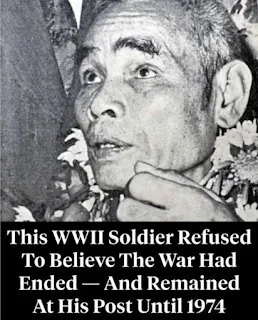The Lonely Life Of Teruo Nakamura, The World War II Soldier Who Stayed At His Post For 30 Years.
The "last of the last" of the World War II holdouts, Teruo Nakamura refused to believe the war had ended and lived in a tiny hut on Indonesia's Morotai Island until he was discovered in 1974.
Many know the story of Hiroo Onoda, the Japanese soldier who refused to believe World War II had ended and didn’t surrender until February 1974. While he is frequently referred to as the last World War II holdout, there is another lesser-known soldier who wasn’t discovered until ten months after Onoda. His name was Teruo Nakamura.
By the 1970s, World War II had been over for nearly three decades. Young soldiers had returned home, started families, and entered middle age. But on Dec. 18, 1974, news broke that one man had never gotten the memo of the war’s end.
Nakamura was discovered on the Indonesian island of Morotai, where he’d been stationed in 1944. After a bloody battle in September of that year, Nakamura had been presumed dead — but he was actually deep in the island’s jungle with several other Japanese soldiers, ready to conduct guerrilla warfare as their commander had ordered.
This final World War II holdout emerged after 30 years of living in near isolation to see the whole world had changed. The discovery of Teruo Nakamura sparked significant public discussion of loyalty, ethnicity, and veteran support.
Teruo Nakamura Enlisted In 1943, But He Didn’t Know It Would Be 30 Years Before He Returned Home
Teruo Nakamura was born Attun Palalin on Oct. 8, 1919 in Taiwan. Also called Suniuo, he was a member of the Amis tribe, a Taiwanese Indigenous group. Nakamura was raised in poverty in the island’s mountains.
This cultural diversity would cause a number of debates later in Nakamura’s life. But when he enlisted in the Takasago Volunteer Unit of the Japanese Imperial Army in November 1943, there was little interest in his background.
Nakamura was stationed on Morotai Island in the Dutch East Indies soon after his enlistment. On Sept. 15, 1944, American and Australian forces attacked the island in a mission that became known as the Battle of Morotai.
The Japanese soldiers fought hard, but they were vastly outnumbered and suffered heavy casualties. Many of the remaining men surrendered to Allied troops, but some retreated into the thick jungle interior of the island. According to TIME, Nakamura’s unit had been commanded to conduct guerrilla warfare in such circumstances. He later told a reporter, “My commanding officer told me to fight it out.” So that’s what he did.
Over the next few months, many of the remaining members of the Japanese Army were captured, surrendered, or died of disease or starvation. But Teruo Nakamura remained with a small group of stragglers, determined to continue following commands even though they had no way to communicate with the outside world.
With no record of Nakamura’s surrender, the Japanese Army declared him dead on Nov. 13, 1944. It would be 30 years before his family learned the truth.
Teruo Nakamura Survived By Eating Bananas And Fishing In The Island’s Waters
Teruo Nakamura lived with several other Japanese soldiers on Morotai Island for twelve years. Since they had lost radio contact with their commanders, they had no idea the war had ended. When leaflets were dropped over the island in 1945 declaring that Japan had surrendered and the war was over, Nakamura and his comrades dismissed them as enemy propaganda.
Nakamura later told the Taipei Times that he believed the war was still ongoing due to airplanes that were constantly flying over the island. As the planes became more modern, he assumed there was an arms race occurring between the Allied and Axis powers. In reality, there was an Indonesian Air Force base nearby, and he was seeing daily practice flights.
In 1956, Nakamura left his fellow troops and set off on his own — some say because the other men tried to kill him. He built a small hut in a field and survived by growing sweet potatoes and eating bananas off of trees. He entertained himself by fishing and fiddling with an abacus he made. He cooked only when it was dark so enemies wouldn’t see the smoke from his fire.
Teruo Nakamura counted the days that passed by observing the moon cycles, and he kept track of months and years by tying knots in a rope.
“I calmly stayed alive there,” he later said. “Although I didn’t have anybody to talk to, buried deep in my heart seemed to be a glimmer of hope and expectation. The only trace of happiness during this time came from the fact that I was still alive and I hadn’t lost my sense of.....
Thanks for reading leave your thoughts in the comments section below
Read more on our Rare History Channel












Comments
Post a Comment